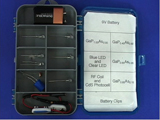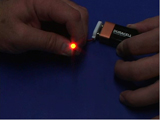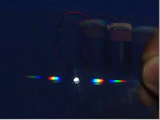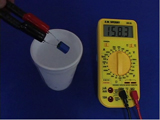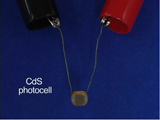
Periodic Properties and Light Emitting Diodes
This experiment was written by Arthur B. Ellis and Lynn Hunsberger, Department of Chemistry, University of Wisconsin-Madison, Madison, WI 53706 and George C Lisensky, Department of Chemistry, Beloit College, Beloit, WI 53511. Adapted with permission from Teaching General Chemistry: A Materials Science Companion. © 1993 American Chemical Society. by Maria Cooper, Michael J. Shaw, and Eric J. Voss, Department of Chemistry, Southern Illinois University, Edwardsville, IL 62026. Support for this experiment was provided by the Southern Illinois University Edwardsville Excellence in Undergraduate Education Fund.
In this experiment you will relate observed properties such as the color, wavelength and energy of light, and excitation voltage for a series of compound semiconductors to composition and periodic trends. In addition, you will observe how electrical resistance of a metal changes with temperature and how electrical resistance of a semiconductor changes under illumination. A key objective of this experiment is to relate the solid-state structure to physical properties of these materials.
| Procedure | Wear eye protection |
Thermal gloves recommended |
Caution: liquid nitrogen is extremely cold. Do NOT allow it to come into contact with skin or clothing, as severe frostbite may result. |
When you open the box with "Periodic Properties and Light Emitting Diodes " on top, this is what you will see. Please note where pieces are so that you are able to return them in the correct place when you are finished. It is especially important to return the clear plastic diffraction grating sheet at the end of the experiment. Using the circuit containing the 1-kΩ resistor (it has a red stripe), connect the battery snap to a 9-volt battery. The circuit is “turned on” by inserting the LED into the socket. Does it matter which way the LED is inserted? Obtain an LED reference strip box. View the LEDs through the diffraction grating sheet oriented so that the light from the LEDs is diffracted away from the reference strip. Plug the white LED into the circuit containing the 1-kΩ resistor and view it through the diffraction grating. With the LED plugged into the circuit containing the 1-MΩ resistor (it has a green stripe) with the battery attached, measure the voltage across the LED using the multimeter. To do so you must attach the red alligator clip to the side of the LED that is plugged into the red wire and the black alligator clip to the black side. The meter must be set to measure in the 20 Volts DC setting. After taking a room temperature measurement, plunge the LED into a foam coffee cup containing liquid nitrogen. Caution: liquid nitrogen is extremely cold. Do NOT allow it to come into contact with skin or clothing, as severe frostbite may result. With the LED still submerged, take a low temperature voltage reading. Place each LED into the 1-kΩ circuit and attach the 9V battery. Dip the LED into liquid nitrogen in a foam coffee cup and then view it through the diffraction grating. Caution: liquid nitrogen is extremely cold. Do NOT allow it to come into contact with skin or clothing, as severe frostbite may result. Resistance measures the difficulty with which an electron moves through a material. Use a digital voltmeter on the resistance setting (200 Ω) to record the resistance of a copper RF coil. The small resistance to electrical current (flow of electrons) in metals is due to vibrations of the atoms that interfere with the flow of electrons. Dip the copper RF coil into liquid nitrogen. Caution: liquid nitrogen is extremely cold. Do NOT allow it to come into contact with skin or clothing, as severe frostbite may result. Did the resistance change? Use a digital voltmeter on the resistance setting (2000 Ω) to record the resistance of a CdS semiconductor photocell. Cover the photocell with your hand to block out most of the light. Does the resistance change with light exposure? Do not dip the photocell in liquid nitrogen; the plastic casing will crack!
LED Tackle Box
Plano Magnum Storage Box
Angler Supply, #3213-09, $4.39 ea.
Diffraction Grating, Flinn C-Spectra
Flinn Scientific, #AP1714, $14.95 per 8" x 10" sheet.
Battery, 9 Volt
Red Super Bright Water Clear T-1 3/4 LED
Mouser Electronics, #512-MV8112, $0.20 ea in lots of 100.
Orange Super Bright Water Clear T-1 3/4 LED
Mouser Electronics, #512-MV8713, $0.38 ea in lots of 100.
Yellow Super Bright Water Clear T-1 3/4 LED
Mouser Electronics, #512-MV8313, $0.38 ea in lots of 100.
Green Super Bright Water Clear T-1 3/4 LED
Mouser Electronics, #512-MV8412, $0.29 ea in lots of 100.
Blue Water Clear T-1 3/4 LED
Mouser Electronics, #606-CMD383UBC/H2, $2.52 ea.
White Water Clear T-1 3/4 LED
Mouser Electronics, #606-CMD333UWC, $3.02 ea.
Economy Encapsulated RF Choke
Mouser Electronics, #43LJ415, $1.18 ea.
CdS Photocell
Jameco Electronics, #202403, $1.49 ea.
1.0 kΩ Battery Clip Circuit, (see below)
1.0 MΩ Battery Clip Circuit, (see below)
Battery Clip Circuits (one with 1.0 kΩ resistor and one with 1.0 MΩ resistor)
Battery Clip, Molded, 6 inch Leads
Mouser Electronics, #123-7016, $0.83 ea.
1.0 kΩ 1/4W Carbon Film Resistor
Mouser Electronics, #291-1K, $0.009 ea in lots of 200.
1.0 MΩ 1/4W Carbon Film Resistor
Mouser Electronics, #291-1M, $0.009 ea in lots of 200.
SIP Break-A-Way Socket, 10 Pin Strip (break off in pair)
Mouser Electronics, #506-510-AG91D, $2.00 ea.
Heat Shrink Tubing
Radio Shack, #278-1627, $2.39 pk.
LED Reference Strip Box
Molded ABS Plastic Case, Gray
Mouser Electronics, #400-1542, $3.70 ea.
Battery, 9 Volt
Red Super Bright Water Clear T-1 3/4 LED
Mouser Electronics, #512-MV8112, $0.20 ea in lots of 100.
Orange Super Bright Water Clear T-1 3/4 LED
Mouser Electronics, #512-MV8713, $0.38 ea in lots of 100.
Yellow Super Bright Water Clear T-1 3/4 LED
Mouser Electronics, #512-MV8313, $0.38 ea in lots of 100.
Green Super Bright Water Clear T-1 3/4 LED
Mouser Electronics, #512-MV8412, $0.29 ea in lots of 100.
Blue Water Clear T-1 3/4 LED
Mouser Electronics, #606-CMD383UBC/H2, $2.52 ea.
Battery Clip, Molded, 6 inch Leads
Mouser Electronics, #123-7016, $0.83 ea.
470Ω 1/4W Carbon Film Resistors (Five)
Mouser Electronics, #291-470, $0.009 ea in lots of 200.
Push Button Switch
Mouser Electronics, #112-R13-502MA-B/B, $2.45 ea.
Electrical Tape (to fasten 9 Volt battery inside of box)
Other Materials
Liquid Nitrogen
Polystyrene Coffee Cup
Multimeter, Model 26833-00
Cole Parmer, #EW-26833-00, $68.25 ea.
Alligator Clip Adapters
Radio Shack, #270-354, $2.99 pr.
This page created by Eric Voss, Southern Illinois University Edwardsville. Last modified July 11, 2008 .
